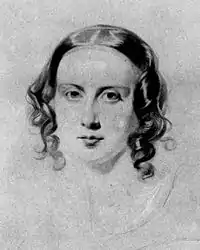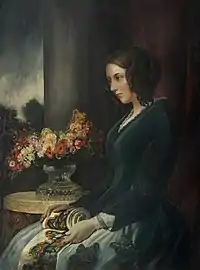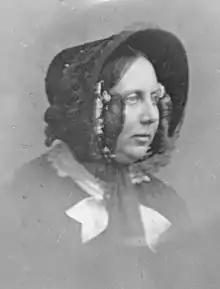Catherine Dickens
Catherine Thomson "Kate" Dickens (née Hogarth; 19 May 1815 – 22 November 1879) was the wife of English novelist Charles Dickens, and the mother of his ten children.
Catherine Dickens | |
|---|---|
 | |
| Born | Catherine Thomson Hogarth 19 May 1815 Edinburgh, Scotland |
| Died | 22 November 1879 (aged 64) London, England |
| Resting place | Highgate Cemetery, London, England |
| Known for | Wife of English novelist Charles Dickens |
| Spouse(s) | |
| Children | Charles Culliford Boz Dickens Mary Dickens Kate Macready Dickens Walter Landor Dickens Francis Jeffrey Dickens Alfred D'Orsay Tennyson Dickens Sydney Smith Haldimand Dickens Sir Henry Fielding Dickens Dora Annie Dickens Edward Dickens |
| Parent(s) | George Hogarth Georgina Thomson |
Early life

Born in Edinburgh, Scotland, in 1815, Catherine moved to England with her family in 1824. She was the eldest daughter of 10 children to George Hogarth. Her father was a journalist for the Edinburgh Courant, and later became a writer and music critic for the Morning Chronicle, where Dickens was a young journalist, and later the editor of the Evening Chronicle. Dickens immediately took a liking to the beautiful 19 year old Catherine and invited her to his 23rd birthday party. Catherine and Dickens later became engaged in 1835 and were married on 2 April 1836 in St Luke's Church, Chelsea, going on their honeymoon in Chalk, near Chatham in Kent. They set up a home in Bloomsbury, and went on to have ten children. During that period, Charles wrote that even if he were to become rich and famous, he would never be as happy as he was in that small flat with Catherine.
Catherine's sister, Mary Hogarth, entered Dickens's Doughty Street household to offer support to her newly married sister and brother-in-law. It was not unusual for the unwed sister of a new wife to live with and help a newly married couple. Dickens became very attached to Mary, and she died in his arms after a brief illness in 1837. She became a character in many of his books, and her death is fictionalised as the death of Little Nell.[2]
Catherine's younger sister, Georgina Hogarth, joined the Dickens family household in 1842 when Dickens and Catherine sailed to America, caring for the young family they had left behind. During their trip, Dickens wrote in a letter to a friend that Catherine never felt gloomy or lost courage throughout their long journey by ship, and "adapted to any circumstances without complaint". 1845, Charles Dickens produced the amateur theatrical Every Man in his Humour for the benefit of Leigh Hunt. In a subsequent performance, Catherine Dickens, who had a minor role, fell through a trap door.[3] In 1851, as 'Lady Maria Clutterbuck', Catherine Dickens published a cookery book, What Shall we Have for Dinner? Satisfactorily Answered by Numerous Bills of Fare for from Two to Eighteen Persons. It contained many suggested menus for meals of varying complexity together with a few recipes. It went through several editions until 1860.[4] Also in 1851, she suffered a nervous collapse after the death of her daughter Dora Dickens, aged nearly 8 months.
Over the subsequent years, Dickens found Catherine an increasingly incompetent mother and housekeeper and blamed her for the birth of their 10 children, which caused him financial worries. He had hoped to have no more after the birth of their fourth son Walter, and he claimed that her coming from a large family had caused so many children to be born. He even tried to have her diagnosed as mentally ill in order to commit her in an insane asylum. As well as this, to ensure no more children could be born, he ordered their bed to be separated and put a bookshelf in between them. [5] Their separation in May 1858, after Catherine accidentally received a bracelet meant for Ellen Ternan, was much publicised and rumours of Dickens' affairs were numerous—all of which he strenuously denied.
Separation

In June 1858, Charles and Catherine Dickens separated, and she moved into a property on Gloucester Crescent in Camden Town. The exact cause of the separation is unknown, although attention at the time and since has focused on rumours of an affair between Dickens and Ellen Ternan and/or Catherine's sister, Georgina Hogarth.
A bracelet intended for Ellen Ternan had supposedly been delivered to the Dickens household some months previously, leading to accusation and denial. Dickens' friend, William Makepeace Thackeray, later asserted that Dickens's separation from Catherine was due to a liaison with Ternan, rather than with Georgina Hogarth as had been put to him. This remark coming to Dickens' attention, Dickens was so infuriated that it almost put an end to the Dickens–Thackeray friendship.[6]
Georgina, Charles and all of the children except Charles Dickens, Jr., remained in their home at Tavistock House, while Catherine and Charles Jr. moved out. Georgina Hogarth ran Dickens' household. On 12 June 1858, he published an article in his journal, Household Words, denying rumours about the separation while neither articulating them nor clarifying the situation.
Some domestic trouble of mine, of long-standing, on which I will make no further remark than that it claims to be respected, as being of a sacredly private nature, has lately been brought to an arrangement, which involves no anger or ill-will of any kind, and the whole origin, progress, and surrounding circumstances of which have been, throughout, within the knowledge of my children. It is amicably composed, and its details have now to be forgotten by those concerned in it... By some means, arising out of wickedness, or out of folly, or out of inconceivable wild chance, or out of all three, this trouble has been the occasion of misrepresentations, mostly grossly false, most monstrous, and most cruel – involving, not only me, but innocent persons dear to my heart... I most solemnly declare, then – and this I do both in my own name and in my wife's name – that all the lately whispered rumours touching the trouble, at which I have glanced, are abominably false. And whosoever repeats one of them after this denial, will lie as wilfully and as foully as it is possible for any false witness to lie, before heaven and earth.
He sent this statement to the newspapers, including The Times, and many reprinted it. He fell out with Bradbury and Evans, his publishers, because they refused to publish his statement in Punch as they thought it unsuitable for a humorous periodical. Another public statement appeared in the New York Tribune, which later found its way into several British newspapers. In this statement, Dickens declared that it had been only Georgina Hogarth who had held the family together for some time:
...I will merely remark of [my wife] that some peculiarity of her character has thrown all the children on someone else. I do not know – I cannot by any stretch of fancy imagine – what would have become of them but for this aunt, who has grown up with them, to whom they are devoted, and who has sacrificed the best part of her youth and life to them. She has remonstrated, reasoned, suffered, and toiled, again and again, to prevent a separation between Mrs. Dickens and me. Mrs. Dickens has often expressed to her sense of affectionate care and devotion in her home – never more strongly than within the last twelve months.[7]
Later years

Dickens and Catherine had little correspondence after their separation, but she remained attached and loyal to her husband and to his memory until her own death from cancer. On her deathbed in 1879, Catherine gave the collection of letters she had received from Dickens to her daughter Kate, telling her to "Give these to the British Museum – that the world may know [Charles] loved me once".[8]
Catherine Dickens was buried in Highgate Cemetery in London with her infant daughter Dora, who had died in 1851 aged nearly 8 months.
In the media
Catherine Dickens was the subject of the sixty-minute BBC Two documentary Mrs Dickens' Family Christmas, broadcast on 30 December 2011 and performed and presented by Sue Perkins, and which looked at the marriage of Charles Dickens through the eyes of Catherine.[9]
In the 1976 series Dickens of London, she was portrayed by Adrienne Burgess.[10]
In the 2013 film The Invisible Woman, she was portrayed by Joanna Scanlan.[11]
In the 2017 film The Man Who Invented Christmas, she was portrayed by Morfydd Clark.[12]
References
- Charles Dickens: An Exhibition to Commemorate the Centenary of His Death. London: Victorian and Albert Museum, 1970. Victorian Web.com
- Victorianweb.org – Mary Scott Hogarth, 1820–1837: Dickens's Beloved Sister-in-Law and Inspiration
- Slater, Michael (1983). Dickens and Women. Stanford University Press. p. 127.
- Susan M Rossi-Wilcox, Dinner for Dickens: The Culinary History of Mrs Charles Dickens' Menu Books, Prospect Books, 2005.
- Malvern, Jack (21 February 2019). "Dickens's dastardly plan for his wife". The Times.
- Nisbet, Ada (1952). Dickens and Ellen Ternan. University of California Press.
- Household Words. 12 June 1858.
- Slater, Michael (1983). Dickens and Women. Stanford: Stanford University Press. p. 159. ISBN 0460042483. Retrieved 26 September 2016.
- "BBC Two - Mrs Dickens' Family Christmas". BBC. Retrieved 18 April 2019.
- Pointer, Michael (1996). Charles Dickens on the Screen: The Film, Television, and Video Adaptations. Scarecrow Press. p. 177. ISBN 9780810829602.
- Shoard, Catherine (6 September 2013). "The Invisible Woman – Toronto 2013: first look review". The Guardian. Retrieved 18 April 2019.
- "Review | 'The Man Who Invented Christmas' looks at the birth of 'A Christmas Carol'". Washington Post. Retrieved 18 April 2019.
Bibliography
- Nayder, Lillian (2011). The Other Dickens: A Life of Catherine Hogarth, Ithaca, New York: Cornell University Press, ISBN 978-0-8014-4787-7. Disputes Charles Dickens' claim that Catherine was an unfit wife and mother.
External links
| Wikimedia Commons has media related to Catherine Dickens. |
